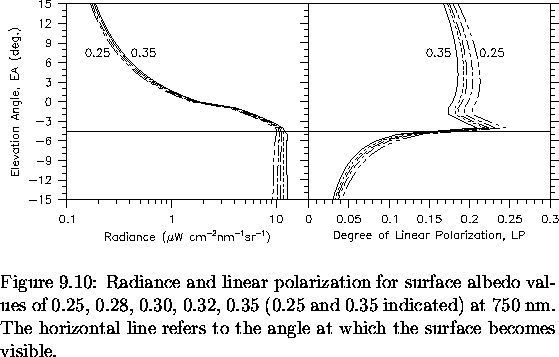
Although not a property of the aerosol profile, surface albedo is nevertheless an important input parameter which will influence both radiance and polarization. Until now, an albedo of 0.3 has been used. Comparisons will be made against albedo values of 0.25, 0.28, 0.32, and 0.35. It is expected that the albedo will be known to at least 0.05 from either satellite data or the retrieval process developed using a combination of the nadir and horizontal flux fields (see Section 3.3 and Appendix A). Results are plotted in Figure 5.14.
As long as there is no direct surface component, the changing albedo
did not have a large impact on radiances. Comparing with
Figures 5.4 and 5.5, a change in albedo of 0.03 is similar to
a change in number density of about 1% or a shift in the profile of
about 0.2 km. Albedo appears to be
more important for polarization as the change between successive curves
is about 0.01. While the shape of the polarization does not change
with albedo, a change in albedo of 0.03 appear similar to a change
in effective radius of <0.01 to 0.03 ![]() m, depending on the
actual value of effective radius (from Figure 5.7). Hence
albedo can potentially have a sizeable impact on the retrieved
size parameters and should be known to at least
m, depending on the
actual value of effective radius (from Figure 5.7). Hence
albedo can potentially have a sizeable impact on the retrieved
size parameters and should be known to at least ![]() .
.
Finally, the impact of a depolarized surface is examined.
While no surface is, in general, completely depolarizing, it is
believed that the polarization of the reflected radiation will be
small. The exception would be Fresnel surfaces near Brewster's
angle, for example; but these are likely to be rare.
The reflected Stokes vector component
![]() is artificially set to,
is artificially set to,
| (9.8) |
The effects of non-Lambertian surfaces could also be examined. However, as the scan steps which would be most influenced by the type of surface are those with a direct surface component and do not contain much aerosol information, this is not of great importance within the context of this study.